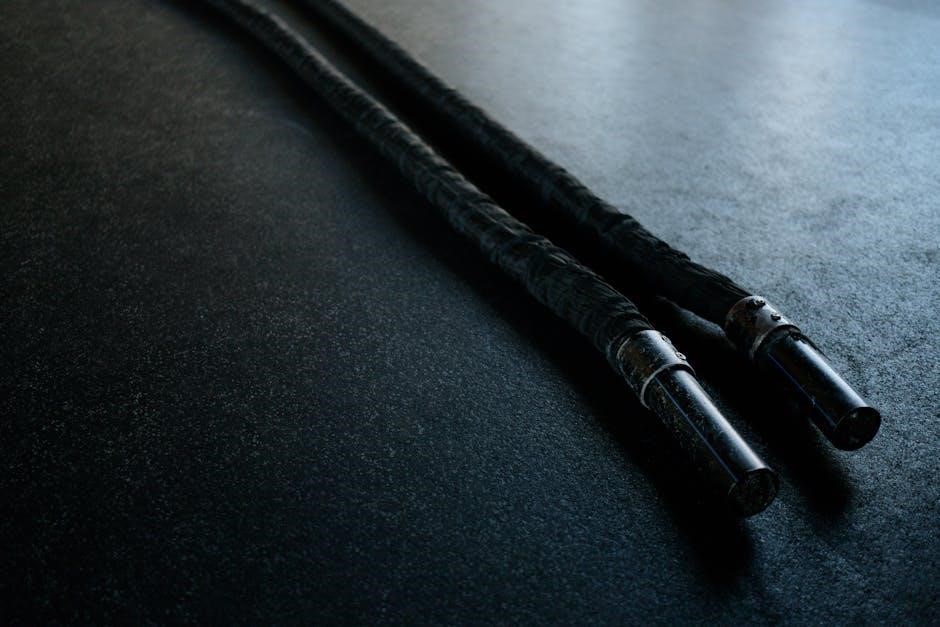Plyometric training‚ or “jump training‚” enhances explosiveness and power. It’s widely used in sports to improve muscle strength and speed. Structured programs‚ like a 4-week plan with 3 workouts weekly‚ focus on exercises such as box jumps and hurdle hops to boost vertical jump and agility. These programs are available as free PDF downloads‚ offering accessible guidance for athletes seeking to elevate their performance.
1.1 What is Plyometric Training?
Plyometric training‚ often called “jump training‚” involves high-intensity movements that enhance muscular power and explosiveness. It focuses on exercises like box jumps‚ depth jumps‚ and burpees‚ which rapidly stretch and contract muscles. This method improves speed‚ agility‚ and vertical leap‚ making it ideal for athletes in sports such as basketball and soccer. Plyometric workouts are structured in programs‚ like 4-week plans with 3 workouts per week‚ targeting specific goals. Available as downloadable PDFs‚ these programs cater to various fitness levels‚ ensuring accessibility and effectiveness for those seeking to enhance performance through dynamic and explosive training routines.
1.2 Benefits of Plyometric Workouts

Plyometric workouts offer numerous benefits‚ including increased vertical jump‚ improved speed‚ and enhanced agility. They boost muscular power by targeting fast-twitch muscle fibers‚ essential for explosive movements. Regular plyometric training also strengthens the lower body‚ enhancing overall athletic performance. Additionally‚ these workouts improve bone density and neuromuscular coordination‚ reducing injury risk. Many programs‚ such as 4-week PDF plans‚ are designed to maximize these benefits through structured exercises like box jumps and hurdle hops. By incorporating plyometrics‚ athletes can achieve significant gains in power and speed‚ making it a valuable addition to any training regimen aimed at elevating sports performance and overall fitness.
1.3 Why Use a Plyometric Workout Program PDF?
A Plyometric Workout Program PDF offers a structured and accessible guide for improving explosive power and agility. These documents provide detailed workout plans‚ such as 3-4 workouts per week‚ with exercises like box jumps and hurdle hops. PDFs are convenient for downloading and printing‚ making them ideal for athletes and coaches. They often include progressions‚ from basic to advanced levels‚ ensuring a tailored approach for different fitness levels. Many programs are free and available online‚ offering a cost-effective solution for enhancing vertical jump and overall athletic performance. Using a PDF program ensures consistency and organization in training‚ helping users achieve their fitness goals efficiently.

Safety Considerations for Plyometric Training
Ensure a safe training environment‚ proper equipment‚ and qualified supervision. Perform health screenings and avoid overexertion to minimize injury risks during explosive movements and landings.
2.1 Warm-Up and Injury Prevention
A proper warm-up is essential to prepare the body for plyometric exercises‚ reducing injury risks. Start with dynamic stretches like high knees‚ leg swings‚ and arm circles. Incorporate light cardio such as jogging or cycling to increase blood flow. Focus on mobilizing the lower body‚ as plyometrics heavily involve the legs and hips. Strengthening core and stabilizer muscles through exercises like planks and glute bridges can improve stability. Emphasize proper landing techniques to avoid stress on joints. A well-structured warm-up routine ensures muscles are ready for explosive movements‚ minimizing the likelihood of strains or overuse injuries. Consistency in preparation is key to long-term safety and performance.
2.2 Proper Technique and Form
Proper technique is critical in plyometric training to maximize results and prevent injuries. Focus on maintaining good body alignment‚ especially during jumps and landings. Keep the chest up‚ shoulders relaxed‚ and knees slightly bent to absorb force. Engage the core to stabilize the body and generate power. Emphasize explosive movements by driving through the hips and pushing off the ground forcefully. Practice quick turnover and rapid muscle contractions to improve reactivity. Avoid rounding the back or letting the knees cave inward‚ as this can lead to poor form and increased injury risk. Technique should always be prioritized over intensity to ensure safe and effective training.
2.3 Understanding Your Fitness Level
Understanding your fitness level is essential for designing an effective plyometric workout program. Assess your current strength‚ power‚ and endurance to determine the appropriate intensity and volume of exercises. Beginners should start with lower-impact movements‚ while advanced athletes can handle more explosive and complex drills. Ignoring your fitness level may lead to injury or poor progress. Use self-assessment or professional evaluation to identify your starting point. Choose exercises that match your capabilities and gradually increase difficulty as you improve. This approach ensures a safe and progressive overload‚ allowing you to achieve optimal results without unnecessary risks.

Structure of a Plyometric Workout Program
A well-structured plyometric program includes warm-ups‚ exercise organization‚ and cool-downs; It balances intensity‚ volume‚ and recovery‚ ensuring progressive overload for enhanced performance and injury prevention.
3.1 Weekly Workout Frequency
A plyometric workout program typically involves 2-3 sessions per week‚ allowing for adequate recovery and adaptation. Beginners may start with 2 sessions to avoid overtraining‚ while intermediate to advanced athletes can manage 3 sessions if recovery strategies are in place. Each session should focus on different aspects of plyometric training‚ such as lower-body explosiveness or upper-body power‚ to avoid overloading specific muscle groups. Rest days are crucial to prevent injury and ensure muscle repair. Consistency is key‚ but flexibility should be maintained based on individual recovery and progress. Proper scheduling ensures balanced development and sustained improvement over time.
3.2 Exercise Selection and Progression
Exercise selection in a plyometric program should prioritize movements that align with your fitness goals and sport-specific requirements. Begin with foundational exercises like box jumps‚ hurdle hops‚ and bounding to build explosive strength. As you progress‚ incorporate more advanced movements such as depth jumps or single-leg plyometrics to challenge power and coordination. Progression can be achieved by increasing jump height‚ distance‚ or resistance. Variations in tempo and reactive training also enhance complexity. Tailor exercises to match individual fitness levels‚ ensuring a gradual increase in intensity to avoid plateaus and prevent overtraining. This structured approach ensures continuous improvement and keeps workouts engaging and effective.
3.3 Duration of the Program
A well-structured plyometric program typically lasts 4 to 12 weeks‚ depending on your fitness level and goals. Beginners may start with a 4-week program to build a foundation‚ while intermediate athletes might opt for 8 to 12 weeks to see significant progress. The duration should allow adequate time for adaptation and recovery‚ as plyometric training stresses the muscles and nervous system. A shorter program (4-6 weeks) focuses on foundational explosive power‚ while longer programs (8-12 weeks) incorporate progressive overload and advanced techniques. Ensure the program duration aligns with your training cycle and season to maximize results and avoid overtraining.

Sample 4-Week Plyometric Program
This program is designed to enhance explosive power and agility over four weeks. It progresses from foundational movements to advanced exercises‚ ensuring safe and effective development.
4.1 Week 1: Foundation and Basics
Week 1 focuses on building a solid foundation with basic plyometric exercises. Start with bodyweight movements like squats‚ lunges‚ and glute bridges to improve strength and coordination. Incorporate essential plyometric drills such as jump squats‚ calf raises‚ and step-ups. These exercises target muscle activation and explosive power. Perform 3 sets of 8-12 repetitions for each exercise‚ ensuring proper form and technique. Include dynamic warm-ups and cooldowns to prevent injury. This phase emphasizes consistency and mastery of fundamental movements‚ creating a safe transition into more advanced exercises in subsequent weeks.
4.2 Week 2: Building Explosive Power
Week 2 shifts focus to enhancing explosive power through more dynamic movements. Introduce exercises like box jumps‚ burpees‚ and depth jumps to challenge power output. Aim for 4 sets of 6-8 repetitions for each exercise‚ emphasizing quick‚ powerful movements. Incorporate lateral bounds and tuck jumps to improve multi-directional explosiveness. Increase intensity by reducing rest periods between sets. Ensure proper form and technique to maximize benefits and minimize injury risk. Dynamic warm-ups and cooldowns remain essential. This phase builds on the foundation established in Week 1‚ progressing toward more advanced plyometric drills;
4.3 Week 3: Increasing Intensity
In Week 3‚ the focus is on increasing intensity by introducing more complex and explosive movements. Exercises like plyometric push-ups‚ single-leg hops‚ and lateral box jumps are added to challenge power and coordination. Aim for 5 sets of 5-7 repetitions‚ reducing rest periods to enhance anaerobic endurance. Incorporate reactive training‚ such as depth jumps with immediate explosive jumps‚ to simulate real-world athletic demands. Progress exercises by increasing height‚ distance‚ or speed. Ensure proper recovery between sessions to avoid overtraining. This phase builds on the strength and explosiveness developed in earlier weeks‚ preparing athletes for high-intensity performance.
4.4 Week 4: Maximal Effort and Testing
Week 4 focuses on maximal effort and testing to assess progress and push limits. Incorporate advanced plyometric exercises like depth jumps‚ max effort box jumps‚ and burpee jumps. Reduce volume but increase intensity‚ aiming for 3-5 sets of 3-5 repetitions at maximum effort. Include speed and agility drills to refine explosiveness. Conduct vertical jump‚ broad jump‚ and sprint tests to measure improvements. Emphasize proper form and recovery to avoid injury. This phase helps athletes gauge their progress and prepare for peak performance. Adjust the program based on test results to refine future training. Recovery remains critical to ensure optimal results and long-term success.

Exercises for Plyometric Training
Plyometric exercises enhance power and agility through explosive movements. Key exercises include box jumps‚ burpees‚ jump squats‚ and depth jumps. These drills improve muscle reactivity and speed.
5.1 Box Jumps and Hurdle Hops
Box jumps and hurdle hops are fundamental plyometric exercises that target explosive power and agility. Box jumps involve jumping onto a sturdy platform‚ focusing on maximum height and proper landing technique. Hurdle hops require jumping over a series of low hurdles‚ improving speed and coordination. Both exercises enhance lower-body strength and reactivity‚ making them essential for athletes seeking to boost vertical jump and acceleration. Incorporating these drills into a plyometric workout program PDF ensures a well-rounded approach to building power and agility. Proper form and progression are crucial to avoid injury and maximize results.
5.2 Bounding and Single-Leg Exercises
Bounding and single-leg exercises are plyometric drills that enhance speed‚ strength‚ and balance. Bounding involves explosive‚ long strides‚ mimicking sprinting but with a focus on power and distance. Single-leg exercises‚ such as single-leg hops and lateral bounds‚ improve stability and symmetry‚ reducing injury risk. These drills are ideal for athletes seeking to enhance agility and unilateral strength. Incorporating them into a plyometric workout program PDF ensures a balanced approach to lower-body development. Proper form‚ including explosive push-offs and smooth landings‚ is essential to maximize benefits and prevent injuries. These exercises are versatile and can be adapted to various fitness levels.
5.3 Depth Jumps and Reactive Training
Depth jumps and reactive training are advanced plyometric exercises that focus on explosive power and quick turnover. Depth jumps involve stepping off a platform and immediately jumping upward upon landing‚ enhancing neuromuscular reactivity. Reactive training incorporates rapid‚ dynamic movements‚ such as box jumps or burpees‚ to simulate sport-specific scenarios. These drills improve acceleration‚ deceleration‚ and overall athleticism. Proper form‚ including soft landings and explosive takeoffs‚ is crucial to avoid injury. Incorporating these exercises into a plyometric workout program PDF ensures athletes can develop high-level reactivity and power. They are particularly beneficial for sports requiring quick changes of direction and explosive movements‚ making them a valuable addition to any training regimen.

Nutrition and Recovery for Plyometric Training
Proper nutrition and recovery are crucial for plyometric training. Focus on balanced meals rich in carbohydrates‚ proteins‚ and fats to fuel workouts and aid muscle repair. Stay hydrated‚ ensure adequate rest‚ and consider stretching or ice baths to enhance recovery and prevent injury.
6.1 Fueling Your Workouts
A well-balanced diet is essential for optimal plyometric performance. Focus on complex carbohydrates for energy‚ lean proteins for muscle repair‚ and healthy fats for overall health. Hydration is critical‚ so drink plenty of water before‚ during‚ and after workouts. Aim for a pre-workout meal rich in carbs and protein 1-2 hours prior to training‚ such as oatmeal with fruit or a protein smoothie. Post-workout‚ consume a mix of carbohydrates and protein within 30-60 minutes to aid recovery. Avoid heavy‚ greasy foods that may cause discomfort during intense movements. Additionally‚ consider electrolyte-rich beverages to replenish lost salts. A proper fueling strategy ensures sustained energy and supports muscle function during plyometric exercises.
6.2 Post-Workout Recovery Strategies
Effective recovery is crucial after plyometric training to repair muscles and enhance performance. Incorporate stretching and foam rolling to improve flexibility and reduce muscle soreness. Ice baths or contrast showers can help reduce inflammation and accelerate recovery. Compression garments may also aid in blood flow and muscle repair. Prioritize rest days to allow your body to rebuild strength. Additionally‚ consider activities like light walking or yoga to promote active recovery. Ensuring adequate sleep and maintaining a balanced diet further support the recovery process. Consistency in these strategies will help optimize results and prevent overtraining.
6.3 Sleep and Rest for Optimal Performance
Sleep and rest are vital for recovery and performance in plyometric training. Aim for 7-9 hours of quality sleep nightly to support muscle repair and energy replenishment. Poor sleep can hinder recovery‚ reducing power and explosiveness. Establish a consistent sleep schedule and create a restful environment to improve sleep quality. Rest days are equally important‚ allowing muscles to recover and rebuild. Incorporate light activities like stretching or yoga on rest days to promote blood flow without overexertion. Prioritizing sleep and rest ensures your body is prepared for intense plyometric workouts‚ enhancing performance and reducing injury risk. Consistency in recovery habits is key to long-term success.

Advanced Plyometric Training Techniques
Advanced plyometric techniques focus on enhancing explosiveness and power through complex movements and progressive overload. They are designed for experienced athletes aiming to optimize performance.
7.1 Plyometric Progression for Intermediate Athletes
Intermediate athletes can progress their plyometric training by increasing intensity‚ volume‚ or complexity. Start with higher box jumps or deeper depths to enhance power output. Gradually introduce multi-directional movements‚ such as lateral bounds or zigzag hops‚ to improve agility. Incorporate reactive training‚ like drop jumps‚ to refine quick-response abilities. Additionally‚ combine plyometrics with resistance‚ such as weighted vests‚ to build strength-endurance. Focus on explosive acceleration drills‚ like sprint jumps‚ to boost speed. Ensure proper recovery and track progress through vertical jump tests or speed assessments to tailor the program effectively. This approach ensures continuous improvement without overtraining.
7.2 Incorporating Resistance and Weighted Plyometrics
Incorporating resistance into plyometric training enhances strength‚ power‚ and endurance. Weighted plyometrics‚ such as weighted box jumps or vest-assisted depth jumps‚ increase intensity by adding external load. Resistance bands can also be used to create tension during explosive movements‚ like banded jump squats. Start with lighter weights or bands to maintain proper form and gradually increase resistance as strength improves. Focus on exercises that combine speed and load‚ such as weighted lateral bounds or resisted sprints. This approach helps build muscular endurance and explosive power‚ preparing athletes for high-intensity sports. Ensure proper recovery and monitor fatigue to avoid overtraining.
7.3 Sport-Specific Plyometric Drills
Sport-specific plyometric drills are tailored to mimic the explosive movements required in various sports. For basketball‚ this might include high-box jumps or single-leg hops to improve vertical leap. Soccer players benefit from lateral bounds and reactive jumps to enhance agility and acceleration. Football athletes can use depth jumps and burpee variations to build explosive power. Designing drills that replicate game-like scenarios ensures optimal transfer of training to performance. Coaches should assess the sport’s demands and tailor exercises accordingly. Progressing from basic to advanced drills‚ while maintaining proper form‚ is key to maximizing results and reducing injury risk. Sport-specific plyometrics bridge the gap between general training and competition readiness.

Measuring Progress and Results
Track improvements in vertical jump‚ speed‚ and agility through regular assessments. Use data to adjust training intensity and ensure the program remains effective and challenging.
8.1 Tracking Vertical Jump Improvement
Monitoring vertical jump progress is essential to gauge the effectiveness of your plyometric workout program. Use a vertec or jump mat to measure jump height accurately. Perform tests under consistent conditions to ensure reliable data. Record baseline measurements before starting the program and retest every 4 weeks. Focus on incremental improvements rather than chasing dramatic increases. Analyze progress to identify strengths and areas needing attention. Adjust the program intensity or volume based on results. Incorporate video analysis to assess technique and optimize performance. Celebrate small gains to stay motivated and maintain consistency in training. Tracking progress helps refine the program for better outcomes. Stay disciplined and patient for long-term success.
8.2 Assessing Speed and Agility Gains
Evaluate speed and agility improvements through specific drills and tests. Use the 40-yard dash or 20-meter sprint to measure speed gains. Agility can be assessed with cone drills‚ shuttle runs‚ or ladder exercises. Record times consistently to track progress. Incorporate plyometric exercises like lateral bounds and zigzag runs to enhance agility. Use video analysis to review technique and identify areas for improvement. Compare baseline measurements with periodic tests to monitor gains. Adjust the program by increasing intensity or adding complex movements as fitness levels improve. Consistency in testing ensures accurate results. Celebrate improvements to stay motivated and continue refining the program for optimal performance. Tracking progress helps tailor the workout to specific goals. Stay focused on incremental gains for long-term success.
8.3 Adjusting the Program Based on Results
Modify your plyometric program based on performance results to ensure continued progress. Analyze data from vertical jump tests‚ sprint times‚ and agility drills to identify strengths and weaknesses. If gains plateau‚ increase intensity by adding more explosive exercises or weighted plyometrics. Conversely‚ if improvements are significant‚ gradually introduce more complex movements. Adjust the volume or frequency of workouts to avoid overtraining. Incorporate sport-specific drills to better align with personal goals. Use the results to refine the program‚ ensuring it remains challenging and effective. Regular adjustments keep the training dynamic and prevent stagnation‚ fostering continuous improvement and long-term success in plyometric performance.

Common Mistakes to Avoid in Plyometric Training
Overtraining‚ improper form‚ and neglecting recovery are common mistakes. Ignoring warm-ups‚ excessive volume‚ and poor technique can lead to injuries and hinder progress in plyometric training.
9.1 Overtraining and Fatigue
Overtraining and fatigue are common mistakes in plyometric training. Performing high-intensity exercises without adequate rest can lead to muscle strain‚ decreased performance‚ and increased injury risk. Many athletes overlook the importance of recovery‚ pushing their bodies beyond sustainable limits. Signs of overtraining include persistent fatigue‚ muscle soreness‚ and decreased power output. Ignoring these signals can result in prolonged recovery periods or even long-term damage. To avoid this‚ incorporate rest days‚ vary exercise intensity‚ and prioritize proper recovery techniques like stretching and nutrition. A well-balanced plyometric workout program PDF should emphasize progressive overload while allowing time for adaptation to prevent burnout and maintain consistent progress.
9.2 Ignoring Proper Form and Technique
Ignoring proper form and technique is a critical mistake in plyometric training. Poor mechanics can lead to inefficient movements‚ reduced power output‚ and increased risk of injury. Many athletes prioritize intensity over execution‚ which can hinder progress and compromise safety. For example‚ during box jumps‚ improper landing techniques can strain joints‚ while sloppy depth jumps may fail to engage the correct muscle groups. A plyometric workout program PDF should emphasize the importance of mastering basic movements before advancing; Coaches and athletes must focus on maintaining proper posture‚ explosive drive‚ and controlled landings to maximize results and minimize injury risks. Proper technique ensures long-term success and safety in plyometric training.
9.3 Not Incorporating Recovery Days
Not incorporating recovery days is a common mistake that can hinder progress in plyometric training. Plyometric exercises are high-intensity and place significant stress on muscles and joints. Without adequate recovery‚ the body cannot repair and adapt‚ leading to overtraining‚ fatigue‚ and increased injury risk. Recovery days allow muscles to rebuild and strengthen‚ enhancing explosive power and overall performance. Ignoring rest periods can result in plateaus‚ decreased athleticism‚ and long-term damage. A well-structured plyometric workout program PDF should include scheduled recovery days to ensure athletes can train consistently and safely. Proper rest is essential for maximizing the benefits of plyometric training and achieving long-term success.
A well-structured plyometric workout program PDF can significantly enhance athleticism and performance. Consistency‚ proper technique‚ and recovery are key. Continue learning‚ stay motivated‚ and track progress for long-term success.
10.1 Maintaining Consistency in Training
Maintaining consistency in plyometric training is crucial for achieving long-term results. A structured plyometric workout program PDF ensures regularity and progression. Schedule workouts in advance and stick to the plan‚ even during off-seasons. Consistency helps build muscle memory‚ improve technique‚ and enhance explosive power over time. Track progress weekly to stay motivated and adjust the program as needed. Avoid irregular training patterns‚ as they can hinder performance gains. By committing to a consistent routine‚ athletes can maximize the benefits of plyometric training and achieve their goals more effectively.
10.2 Continuing Education and Growth
Continuing education is essential for optimizing plyometric training. Staying updated on the latest research‚ techniques‚ and best practices ensures continuous improvement. Athletes and coaches should seek out workshops‚ online courses‚ and resources like a plyometric workout program PDF to deepen their knowledge. Learning from experienced professionals can refine training methods and prevent plateaus. Exploring new exercises and technologies‚ such as wearable tracking devices‚ can enhance performance. Networking with other athletes and trainers fosters a supportive environment for growth. By embracing lifelong learning‚ individuals can adapt their training to meet evolving goals and stay ahead in their sport or fitness journey.
10.3 Staying Motivated and Engaged
Staying motivated and engaged is crucial for long-term success in plyometric training. Setting clear‚ achievable goals helps maintain focus and drive. Tracking progress through a plyometric workout program PDF can visualize improvements‚ boosting confidence. Celebrating small milestones‚ like increasing jump height or speed‚ reinforces dedication. Varying workouts to avoid monotony keeps sessions exciting. Surrounding yourself with a supportive community or training partner enhances accountability. Rewarding hard work with recovery days or new gear can also motivate. Reminding yourself of the broader benefits‚ such as improved performance and overall health‚ keeps the bigger picture in mind. Consistency and enjoyment are key to sustained engagement.
